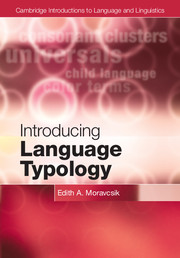Book contents
- Frontmatter
- Contents
- List of figures
- Preface
- List of copyright permissions
- List of abbreviations
- Chapter 1 What is language typology?
- Chapter 2 The worlds of words
- Chapter 3 Assembling words
- Chapter 4 Dissembling words
- Chapter 5 The sounds of languages
- Chapter 6 Language in flux
- Chapter 7 Explaining crosslinguistic preferences
- List of languages mentioned
- Glossary
- References
- Subject index
- Language index
- Author index
Chapter 1 - What is language typology?
Published online by Cambridge University Press: 05 February 2013
- Frontmatter
- Contents
- List of figures
- Preface
- List of copyright permissions
- List of abbreviations
- Chapter 1 What is language typology?
- Chapter 2 The worlds of words
- Chapter 3 Assembling words
- Chapter 4 Dissembling words
- Chapter 5 The sounds of languages
- Chapter 6 Language in flux
- Chapter 7 Explaining crosslinguistic preferences
- List of languages mentioned
- Glossary
- References
- Subject index
- Language index
- Author index
Summary
Chapter outline
In this chapter, the goals of language-typological research will be defined as studying similarities and differences among languages that do not stem from shared genetic relationship, language contact, or shared environmental conditions. Some basic research tools will be introduced: language-typological generalizations of various kinds, ways of constructing language samples, and sources for obtaining language data.
Goals
You are riding in a crowded elevator; next to you stand two people conversing in a foreign language. You don’t understand a word of what they are saying and couldn’t even repeat any of it: their speech strikes you as just plain noise. Yet, the two people obviously communicate. One person says something whereupon the other breaks into a peal of laughter; he then responds and the first person comes back with another round of what sounds like complete gibberish. How can these odd noises make any sense to anybody?
What you have just experienced is a true fact: languages are different. The following examples further illustrate how different they can be. (2), (3), and (4) are Polish, Hungarian, and Turkish translations of the English sentence in (1).
- Type
- Chapter
- Information
- Introducing Language Typology , pp. 1 - 24Publisher: Cambridge University PressPrint publication year: 2012

